PCRF also undertook a Vitareef Study at this site in March 2006.
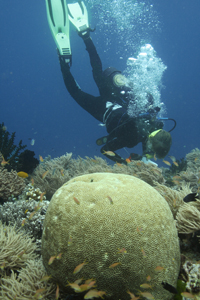 |
(from 2006 reef report)
Papua New Guinea lies within the epicenter of marine biodiversity in the world due to its position between both the Pacific and Indian Oceans. Milne Bay Province is located at the southeast tip of New Guinea Island between the Solomon Sea and the Coral Sea. The bay is six miles long and 19 miles wide. Many volcanic peaks, coral islands and reefs are found in the region. Planktonic-rich water nurtures the marine life in the bay area as tidal currents flow in and out from both seas. The dive sites in the region boast a vast diversity of sea creatures, corals and multiple rare endemic species.
During WWII, a major battle took place in the region, The Battle of the Coral Sea, where Japanese troops suffered their first land defeat when attempting to take control of Milne Bay. Currently, many foreign companies are logging the forests in the Milne Bay Province region. Without the trees, many bare hills erode away and the sediment ultimately washes into bay waters.
Alotau is the provincial capital of the Milne Bay Province. It is a hub for islanders with a commercial centre. It has no road link to Port Moresby and, as a result, maintains a slower pace.
The Magic Spot dive site is located southeast of East Cape by Nuakata Island in the Raven Channel. Strong currents associated with tidal flows oftentimes exceed two knots and bring in both nutritious bay water and cool, oligotrophic oceanic water. Due to the reef’s position on the edge of the channel at the tip of Milne Bay, the marine life is vivacious.
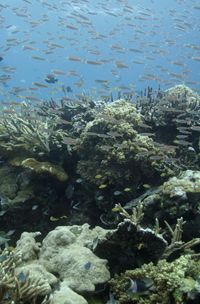 |
(from 2006 reef report)
The Magic Spot is an open ocean reef with neither a central island nor lagoon, thus it is classified as a platform reef. The geological history is unknown but it is located in a region of unusually high seismic activity.
The reef crest is between four to ten meters deep with areas of coral rubble and other areas of rich coral growth. At the edge of the reef crest, the reef drops off as a steep slope until it gradually tapers off to a sand bottom in twenty-five meters of water.
Although no Secci disk readings were taken over the course of the brief study, the visibility was estimated to vary between five and fifteen meters. Heavy rains had been falling during the ten days prior to our study, affecting visibility greatly.
Timing our dives to the two slack tides a day were essential to the success of the data collection as currents were strong and limited our access to certain areas of the site. Unfortunately we were unable to return to certain areas of the reef from which we collected Vitareef data in 2006. However, we were able to make observational dives on these areas.
Temperatures recorded underwater on three dives were 26.1, 26.1 and 26.7 °C giving an average of 26.3 °C. This is significantly lower than the temperatures recorded during the 2006 study which averaged at 29.4 °C.
Only one coral colony in the shallow zone and one in the deep were observed to be suffering from bleaching.
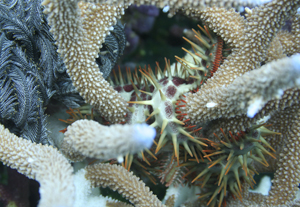 |
One juvenile crown of thorns was sighted during the course of this study. None have been sighted here previously although there were many observed on the nearby Lighthouse Reef in 2006.
One colony in the shallow zone and two colonies in the deep zone were observed to be suffering from white band disease, compared with zero colonies in the shallow zone and ten colonies in the deep zone in 2006.
Overall the hard coral coverage of the reef appeared to be in good health, however, one area surveyed for Vitareef appeared particularly prone to overgrowth – by algae of various forms, sponge and encrusting tunicate. Algal presence in general increased since we studied this reef just over a year ago.
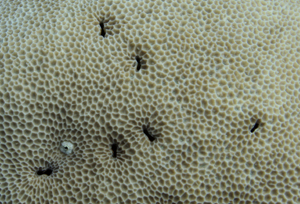 |
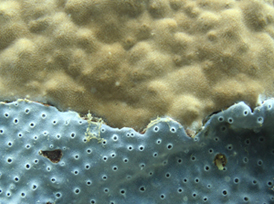 |
| burrowing mussel Lithophaga zittelliana | encrusting sponge on Porites |
In the 2006 reef report, there is a detailed comparison of observations on fish populations at this site between December 2002, when we first dived here, and March 2006, highlighting a marked decrease in predator population, particularly noticeable in the decrease of shark, dogtooth tuna and great barracuda sightings.
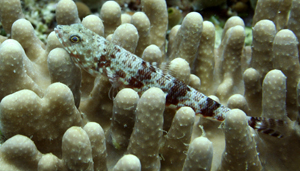 |
There did not appear to be a further deterioration in fish populations between March 2006 and April 2007, plus visibility was greatly reduced in the latter study which decreased the probability of sighting passing predators off the reef slope.
This summary covers the populations of invertebrates at the shallow and deep slopes and the reef tip at Magic Spot.
Sea cucumbers are still being fished on this reef, as noted in the 2006 reef report. During one dive, there were three canoes fishing for sea cucumbers. However, sea cucumbers are still present on the reef, albeit in low numbers. Encrusting sponges and tunicates appear to be the most prevalent invertebrates, especially on the reef top where we conducted most of the Vitareef dives.
A pod of spinner dolphins was feeding beside Magic Spot and SV Infinity at anchor late one afternoon. They were making high jumps and multiple sideways rolls and were unperturbed by our small boat following them. Several times a few of them broke away from the pod to ride the bow of the small boat.
No turtles were sighted during the course of this study.
In 2006, 33.7% of the colonies studied in Vitareef were observed to be under threat. In 2007, this figure had increased to 45.6%. However, overall health has barely changed in the interim, from 39.1% in 2006 to 40.3% in 2007. The most significant increase in threatening conditions appears to be due to overgrowth by algae which rose from 11.7% in 2006 to 18.0% in 2007. This figure corroborates observations of a general increase in algal coverage on this reef. In one area studied for the 2007 Vitareef study, there was a reasonably high incidence of smothering by both macroalgae and filamentous algae.
Overgrowth by invertebrates continues to be an issue facing the health and vitality of this reef. In 2006, 19.9% of colonies in the shallows and 16.0% in the deep were observed to be suffering from overgrowth by invertebrate, predominantly sponge and tunicate. In 2007, 27.5% of colonies in the shallow zone and 26.3% in the deep zone were afflicted by invertebrate overgrowth, again predominantly sponge and encrusting tunicates.
There was also an increase in the level of sedimentation, from 3.8% in 2006 to 7.2% in 2007 and a slight increase in tissue damage, from 18.3% in 2006 to 20.6% in 2007.
Due to the very strong current conditions, we were unable to survey areas of the reef that were surveyed in 2006 and were restricted to the reeftop. During an observational dive on the reef slope, studied in 2006, it was noted that the reef there appeared to be in approximately the same condition as last year.
In 2006, we were visited by many beche-de-mer fishermen who were using a leaded spear to bring the sea cucumbers to the surface. This year, we encountered three beche-de-mer fishermen working the reef during the course of one dive. We met one dive boat while we were anchored in Raven Channel this year, however the reduced sightings of liveaboard operators in the area is more likely due to us being there for only five days this year rather than a reduced level of activity, since we observed the liveaboards while anchored in Alotau, the nearest town.
Magic Spot has become a significant study site to us since it represents the health and vitality of the reefs in the Raven Channel. We will return here late this year and will continue to monitor its health and vitality.
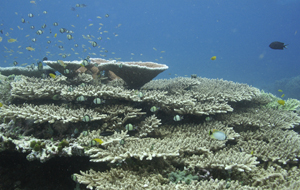 |